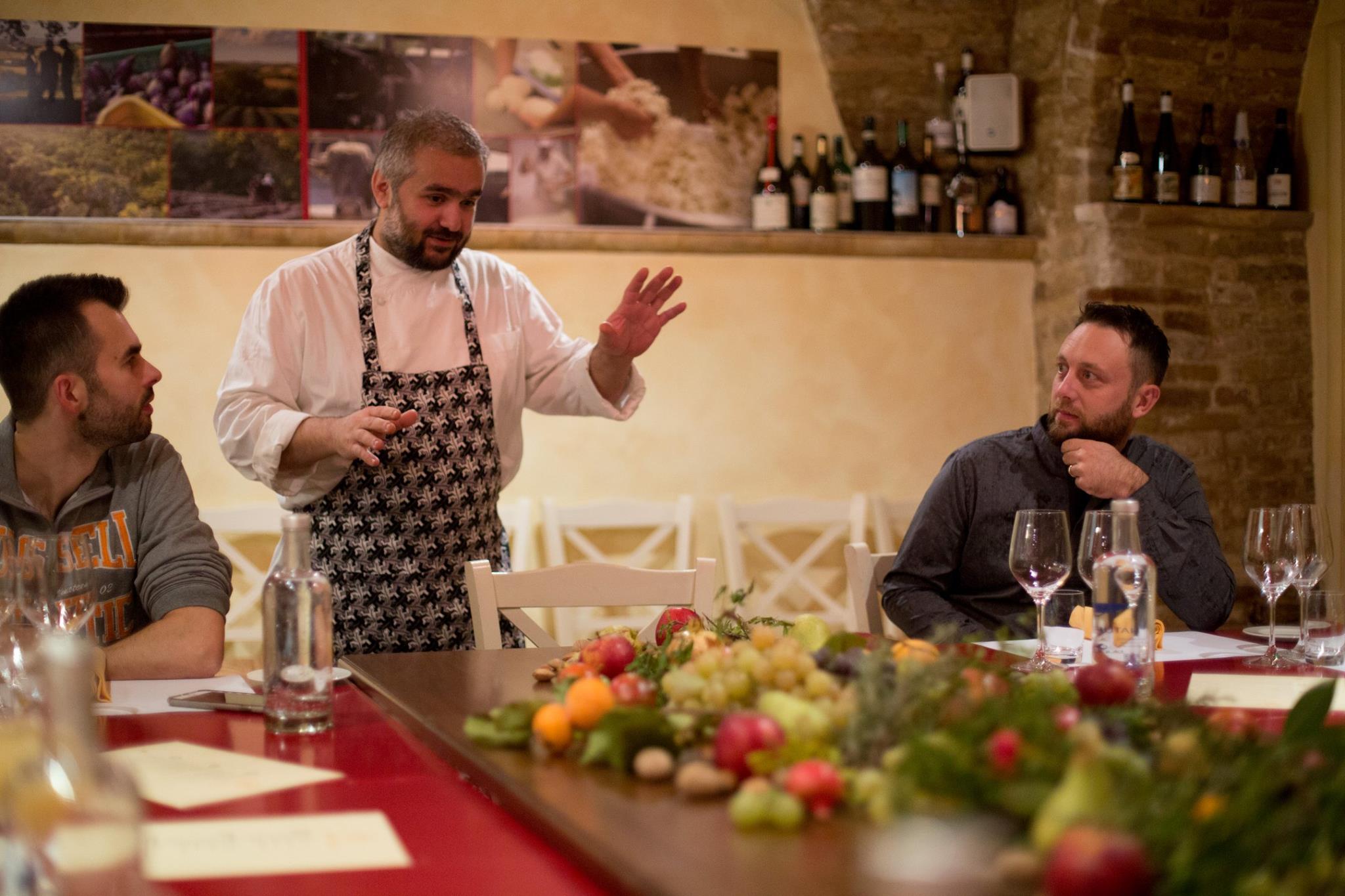{: it}
Filottrano stands on the gentle hills a few kilometers from Jesi. Known above all for an epidemic capillary diffusion of factories and outlets for men's clothing (I once tried to calculate the average of one textile company for every 6 inhabitants), of large and small brands or of common subcontractors, up to the invention - for the Marche region - of tailor-made clothing for men, perhaps known to sportsmen for having dressed prestigious teams and some VIPs.
But, like every village in this area, it is a treasure chest of traditional flavours. Not many years ago, in 2014, the Red Rooster appeared on the ancient walls of the city, under a small arch in front of the church. Trattoria Gallo Rosso, as the two owners are keen to specify - but perhaps it is more correct to call them "creators" - Gessica Mastri and Andrea Tantucci.
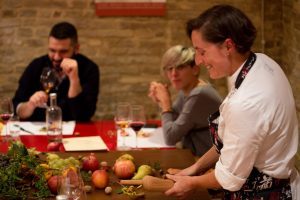
In fact, at Gallo Rosso you can feel the traditional connotation given to the term, but with that bit of contemporary and reworking that makes it unique in local cuisine.
To the question asked of each interviewee ("In a few words, what sets you apart?"), Andrea and Gessica, almost in unison, reply: "We cook what we like to eat at home. The dishes that grandmother prepared, the ingredients and scents that filled the rooms when lunch was being prepared”.
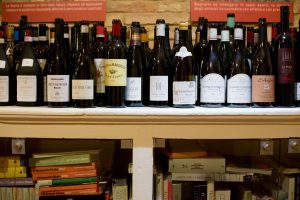
The strong point (it's always the second question, usually) is the ingredients, they repeat it more than once. “It is a cuisine linked to the producers, with a direct relationship – explains Andrea – and this is a fairly unique case in our area: the trattoria that wants to have an easy life presents a menu with a first course with meat sauce, a mixed roast... We, in each dish, we tell the story behind it: I present you not only my work, but also the passion, the sweat of those who worked on it before me. It is something more than a simple recipe: we build the menu from the available raw materials."
And every two or three sentences Andrea and Gessica bring up a name like Doriano Scibè, the Piandelmedico dairy, the Mancini pasta factory or the Valeri oil mill. They call them by name (Doriano, Giulia...), as if they were family members: “Doriano brings you the meat when he can, what there is, according to season. Maybe he arrives at 4 in the morning to unload, when she has finished her work on the farm. The ingredient doesn't arrive by courier, in vacuum-packed bags that you can cut and throw in the pan and after a few minutes it's ready. No, these are the ingredients that once existed. They are difficult products to work with, but you notice it immediately on the palate, before thinking about how they are treated, what the recipe is", Gessica and Andrea tell us with passion and fun.
IN three words, the Red Rooster is: Raw Material, Tradition and Conviviality (it is the extreme synthesis that I extract from the two). “I believe that those who come here – says Andrea – already have an idea of where they are, of the Marche. It is a mirror of what we have around us: not a true zero km, but the best of what we have around us, which we work well, respecting animals. Therefore, no products from intensive farming or agriculture."
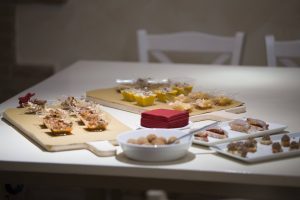
Understanding that two pillars are raw materials and tradition is easy, just take a look at the menu. The main dish here is goose cooked in Verdicchio: Gianni Mura sang its praises above On Friday of Repubblica, in its Mangia e Bevi column, advising "everyone to come to Filottrano to eat goose cooked in Verdicchio at the Trattoria Gallo Rosso”. You can find it on the menu all year round, except in the three winter months (tradition, as we were saying); or macaroni with bat goose (the sauce that was made during the wheat threshing period... ancient tradition, in fact); on the first courses we also find Gallo Rosso tagliatelle, with a jus of meat and parmesan; or the "dish you don't expect", as Andrea defines it, boiled rabbit served with salted anchovies and borage: a flood of aromas, before you even see the dish! Or again, the Marche liver pâté (Angus?! What the f@©#!?…) with a reduction of Rosso Piceno and hazelnuts.
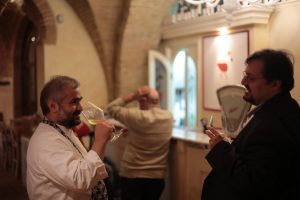
Raw material and tradition: at this point it seems easy and natural to generate conviviality. Well, the two add an extra ingredient. A very full calendar of dedicated events, shows, dinners/conferences on food, history, "music & food" evenings (it is no coincidence: in 2009 Andrea was the author, with Paola De Angelis, of Rockitchen: 30 menus for 30 records Whoever has read it already knows what the mood of these evenings is, events, readings. Just one dogma: whoever leads these evenings and talks about music, food, wine, poetry must be a professional. Any names, besides the aforementioned De Angelis? Just to mention those in the programs to come, Tommaso Lucchetti,Romina Antonelli, Michele Alesiani… there is something for every taste, for every sense.
{:} {: en}
Filottrano lies upon the gentle hills a few kilometers away from Jesi. It is well known for a widespread epidemic dissemination of men's wear factory stores and fashion outlets (once I calculated a range of a textile factory each 6 inhabitants), of unknown and famous brands or common subcontractors, up to the invention – for the Marche region – of the custom tailored suits for men, suits worn by sports' teams and VIPs.
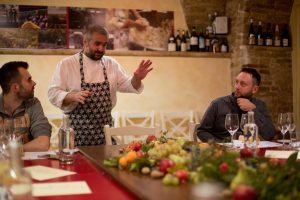
Such as many other villages in our region, Filottrano is a treasure chest for traditional flavors. In 2014, not so many years ago, Gallo Rosso was established on the ancient town walls under a small arch in front of the church. Gallo Rosso is a Trattoria indeed, as its two owners – or maybe better call them “creators”, Gessica Mastri and Andrea Tantucci – want to underline.
In fact, at the Gallo Rosso you feel the traditional connotation of the word, but also added with a contemporary touch and reprocessing style that make the trattoria a unique experience compared to the local cuisine.
To the question that every interviewer asks (“In a couple of words, what is your distinctive feature?”), Andrea and Gessica – almost in unison – answer: “We cook what we love eating at home. The dishes my grandpa used to cook, ingredients and smell that could fill the rooms while cooking for lunch.”

Our strong point (is usually always the second question) is the ingredients they use, they repeat that more than once. “Our cuisine is firmly connected to producers, by a direct relationship – Andrea explains – and this a unique situation in our area: much easier would be a trattoria where you can eat Pasta al Ragù as first course, and roast meat to follow… We tell the story of each dish we offer, instead: I don't want to present only my work, but also the passion and sweat of everyone who has worked to produce the food. It is something more than just a simple recipe: our menu comes from the available raw materials”.
Every two or three sentences Andrea and Gessica tell me about Doriano Scibè, the cheese factory Piandelmedico, the pasta factory Mancini or olive oil factory Valeri. They call the suppliers by first name (Doriano, Giulia…), as if they were one of the family: “Doriano supplies meat whenever he can, what is fresh and available at the moment, in accordance with the season. It might happen that he delivers at 4 am in the morning, after he finished his job at the farm. Ingredients are not delivered by couriers in vacuum-sealed bags that you can open and cook in a few minutes. The ingredients we use, are the ones you used to be cooked in the past. They are products difficult to cook, but you can actually taste the difference, right before you can think of how they were treated and which is the recipe we use”, Andrea and Gessica tell me with passion and amusement.

In three words, Gallo Rosso is: Raw material, Tradition and Conviviality (this is the extreme summary I wrang out of them). “I believe that our customers – says Andrea – already knows our region, Marche. It is just a mirror of what surrounds us: it is not a pure farm-to-table, but it is just the best we have around us, that we cook in the best way, respecting animals. So that we don't use at all products from industrial breeding farms or intensive agriculture”.
It's easy to understand that raw material and tradition are two main features, just taking a look at the menu. The main dish is goose cooked with Verdicchio wine: Gianni Muro on Il Venerdi di Repubblica also praise the dish, in his section Mangia e Bevi advising that “everyone should go to Filottrano and eat Goose cooked with Verdicchio wine at the Trattoria Gallo Rosso”. The dish is all year long on the menu, except during the three winter months (tradition, we said); or Macaroni with Goose “del batte” (the typical sauce used for pasta during the threshing…ancient tradition, as well); among the first courses there are also Tagliatelle Gallo Rosso style, with a “jus” (meat juices) of meats and parmesan cheese; or the “dish you do not expect”, as Andrea defines it, the boiled rabbit served with salted anchovies and borage: a smell profusion, even before you eat it! And still, fois gras pâté of Marchigiana meat (Angus?! What the f@©#!?…) with a reduction of Rosso Piceno red wine and hazelnuts.
Raw material and tradition: at this point it seems easy and natural to create conviality. Well, those two add in another ingredient. A thick agenda of selected events, shows, gala dinners / conferences about food and food history, “music&food” evenings (it's not a case: in 2009 Andrea is author, together with Paola De Angelis, of Rockitchen: 30 menues for 30 LPs. Those who read it, already knows the mood of those events), readings and events. Only one dogma: who manages these events and speaks about music, food, poetry must definitely be an expert. To name a few, together with the said Mrs. De Angelis? Let's name those who will join the shows in the future, Tommaso Lucchetti, Romina Antonelli, Michele Alesiani… for everybody's taste, for every sense.

Such as many other villages in our region, Filottrano is a treasure chest for traditional flavors. In 2014, not so many years ago, Gallo Rosso was established on the ancient town walls under a small arch in front of the church. Gallo Rosso is a Trattoria indeed, as its two owners – or maybe better call them “creators”, Gessica Mastri and Andrea Tantucci – want to underline.
In fact, at the Gallo Rosso you feel the traditional connotation of the word, but also added with a contemporary touch and reprocessing style that make the trattoria a unique experience compared to the local cuisine.
To the question that every interviewer asks (“In a couple of words, what is your distinctive feature?”), Andrea and Gessica – almost in unison – answer: “We cook what we love eating at home. The dishes my grandpa used to cook, ingredients and smell that could fill the rooms while cooking for lunch.”
Our strong point (is usually always the second question) is the ingredients they use, they repeat that more than once. “Our cuisine is firmly connected to producers, by a direct relationship – Andrea explains – and this a unique situation in our area: much easier would be a trattoria where you can eat Pasta al Ragù as first course, and roast meat to follow… We tell the story of each dish we offer, instead: I don't want to present only my work, but also the passion and sweat of everyone who has worked to produce the food. It is something more than just a simple recipe: our menu comes from the available raw materials”.
Every two or three sentences Andrea and Gessica tell me about Doriano Scibè, the cheese factory Piandelmedico, the pasta factory Mancini or olive oil factory Valeri. They call the suppliers by first name (Doriano, Giulia…), as if they were one of the family: “Doriano supplies meat whenever he can, what is fresh and available at the moment, in accordance with the season. It might happen that he delivers at 4 am in the morning, after he finished his job at the farm. Ingredients are not delivered by couriers in vacuum-sealed bags that you can open and cook in a few minutes. The ingredients we use, are the ones you used to be cooked in the past. They are products difficult to cook, but you can actually taste the difference, right before you can think of how they were treated and which is the recipe we use”, Andrea and Gessica tell me with passion and amusement.
In three words, Gallo Rosso is: Raw material, Tradition and Conviviality (this is the extreme summary I wrang out of them). “I believe that our customers – says Andrea – already knows our region, Marche. It is just a mirror of what surrounds us: it is not a pure farm-to-table, but it is just the best we have around us, that we cook in the best way, respecting animals. So that we don't use at all products from industrial breeding farms or intensive agriculture”.
It's easy to understand that raw material and tradition are two main features, just taking a look at the menu. The main dish is goose cooked with Verdicchio wine: Gianni Muro on Il Venerdi di Repubblica also praise the dish, in his section Mangia e Bevi advising that “everyone should go to Filottrano and eat Goose cooked with Verdicchio wine at the Trattoria Gallo Rosso”. The dish is all year long on the menu, except during the three winter months (tradition, we said); or Macaroni with Goose “del batte” (the typical sauce used for pasta during the threshing…ancient tradition, as well); among the first courses there are also Tagliatelle Gallo Rosso style, with a “jus” (meat juices) of meats and parmesan cheese; or the “dish you do not expect”, as Andrea defines it, the boiled rabbit served with salted anchovies and borage: a smell profusion, even before you eat it! And still, fois gras pâté of Marchigiana meat (Angus?! What the f@©#!?…) with a reduction of Rosso Piceno red wine and hazelnuts.
Raw material and tradition: at this point it seems easy and natural to create conviality. Well, those two add in another ingredient. A thick agenda of selected events, shows, gala dinners / conferences about food and food history, “music&food” evenings (it's not a case: in 2009 Andrea is author, together with Paola De Angelis, of Rockitchen: 30 menues for 30 LPs. Those who read it, already knows the mood of those events), readings and events. Only one dogma: who manages these events and speaks about music, food, poetry must definitely be an expert. To name a few, together with the said Mrs. De Angelis? Let's name those who will join the shows in the future, Tommaso Lucchetti, Romina Antonelli, Michele Alesiani… for everybody's taste, for every sense.
{:}

